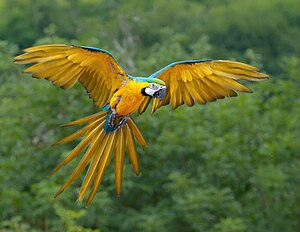Actual macaws
| Actual macaws | ||||||||||
|---|---|---|---|---|---|---|---|---|---|---|

Yellow and breasted Macaw ( Ara ararauna ), with the long tail feathers typical of all macaws and the powerful beak |
||||||||||
| Systematics | ||||||||||
|
||||||||||
| Scientific name | ||||||||||
| Era | ||||||||||
| Lacépède , 1799 |
The ( real ) macaws ( Ara ) form a genus within the family of the real parrots (Psittacidae). They are all native to South and Central America. The scope of the genus has long been a matter of controversy. According to today's view, eight species belong to this genus.
The word macaw is of indigenous origin, which was formed onomatopoeically from the cry of the animals. However, these typical sounds are unique to the large species. The genus was first defined by the French naturalist Bernhard Germain de Lacépède in 1799.
features
Within the genus Ara , size and coloration vary widely, but the body shape is generally similar. All real macaws have a face mask that consists of a larger area of skin on both sides of the face, which is completely featherless or has only a few rows of very small feathers. The head is broad with a very large and powerful beak. The tail is long and tiered. There is no gender dimorphism .
Systematics
The scope of the genus is controversial. According to today's view, only the following eight species belong to this genus:
- Yellow-breasted Macaw ( Ara ararauna )
- Blue- throated Macaw, also Blue-throated Macaw or Caninde's Macaw ( Ara glaucogularis )
- Little soldier macaw ( Ara militaris )
- Great Macaw ( Ara ambiguus )
- Scarlet Macaw ( Ara macao )
- Green-winged macaw, also dark red macaw ( Ara chloropterus )
- Red-eared macaw ( Ara rubrogenys )
- Red Bugara ( Ara severa )
Traditionally, the real macaws also included the following species:
- † Cuban Macaw ( Ara tricolor )
- Red-bellied Macaw ( Ara manilata )
- Red-backed Macaw ( Ara maracana )
- Blue-headed macaw , also mountain macaw ( Ara couloni )
- Golden-necked Macaw ( Ara auricollis )
- Hahn's Dwarf Macaw ( Ara nobilis )
Red-bellied Macaw (now: Orthopsittaca manilata ) and Hahn's Dwarf Macaw (now: Diopsittica nobilis ) were each placed in their own genera. Red-backed macaws, blue-headed macaws and golden-necked macaws were separated from Ara as genus Primolius .
Extinct species without clear evidence
Furthermore, Rothschild’s Extinct Birds mentions seven other species that have already become extinct. These macaws were islanders in the Greater and Lesser Antilles. Evidence that these populations were separate species or rather subspecies of still existing nominate forms could not be provided due to the rapid extinction. However, numerous contemporary accounts of these parrot species have come down to us (e.g. Atwood, 1791; Du Tertre, 1654, 1677; Gosse, 1847; Labat, 1742).
- Dominica Macaw ( Ara atwoodi ) - Dominica
- St. Croix's Macaw ( Ara autocthones ) - Saint Croix
- Blue and Yellow Macaw ( Ara erythrura ) - West Indies (sometimes described as a synonym for the Martinique Macaw)
- Red-headed Macaw ( Ara erythrocephala ) - Jamaica
- Yellow- fronted Macaw ( Ara gossei ) - Jamaica
- Guadeloupe Macaw ( Ara guadeloupensis ) - Guadeloupe
- Martinique Macaw ( Ara martinica ) - Martinique
swell
Individual evidence
- ^ A b F. Gill & D. Donsker (Eds) 2011: IOC World Bird Names (version 2.10.) - Parrots. ( Online ( Memento of the original from January 10, 2012 in the Internet Archive ) Info: The archive link was automatically inserted and not yet checked. Please check the original and archive link according to the instructions and then remove this note. , Accessed on December 27, 2011)
literature
- Joseph Michael Forshaw: Parrots of the World . Princeton University Press, Princeton 2006, ISBN 978-0-691-09251-5 .
- Dieter Hoppe : Macaws . Ulmer, Stuttgart 1983, ISBN 3-8001-7081-7 .
- Tony Juniper, Mike Parr: Parrots . Pica Press, Sussex 1998, ISBN 1-873403-40-2 .
- Lars Lepperhoff: Macaws . Ulmer, Stuttgart 2004, ISBN 3-8001-3821-2 .
- Roger G. Sweeney: Macaws. Barron's Educational Series, 2002, ISBN 978-0-7641-1920-0 .
